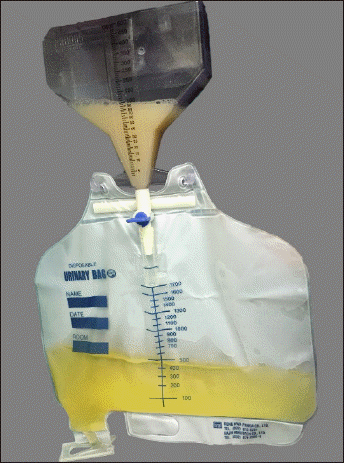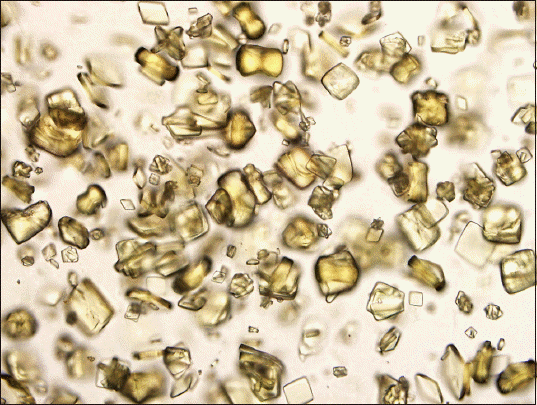INTRODUCTION
Propofol is a widely administered agent in both the fields of anesthesia and critical care medicine, and it has not been reported to cause nephrotoxicity. However, a few rare cases of colored urine after propofol administration have been reported. Reported colors changes are green, white, pink, cloudy pink and cloudy. The presence of phenolic metabolites of propofol is known to cause green urine [1,2], while uric acid is believed to be responsible for other color changes [3-5]. Although low urine pH and low temperature are known to increase the potential for urine discoloration after propofol administration, the incidence is very low. Furthermore, no cases of urine discoloration relating to the patient’s medication have been reported. Here, we report on the development of cloudy urine during general anesthesia using total intravenous anesthesia (TIVA) with 2% propofol in a patient taking hydroxyurea.
CASE REPORT
A 68-year-old man with cervical herniated nucleus pulposus was scheduled for anterior cervical discectomy and fusion. The patient had been taking diltiazem and ramipril for hypertension, metformin for diabetes mellitus, and hydroxyurea for essential thrombocythemia. TIVA was planned as intraoperative motor- evoked potentials monitoring was required. General anesthesia was induced and maintained with target controlled infusion of 2% propofol and remifentanil, in addition to neuromuscular blockade with rocuronium. Cloudy urine was observed 2 h after the initiation of anesthesia (Fig. 1). A urine sample was collected for analysis. Although the urine was cloudy, the drainage of urine was good and vital signs were within normal ranges. Therefore, we did not disrupt the operation and maintained anesthesia using TIVA while observing the urine. The color of urine became progressively clearer over time. In urine sample collected during anesthesia we observed crystals consistent with uric acid under the microscope (Fig. 2). Urine cultures were negative and renal function test results were within normal ranges. However, the serum uric acid level decreased from 6.3 mg/dl to 4.0 mg/dl postoperatively. The urine sample was subjected to a drug test, ultraperformance liquid chromatography-tandem mass spectrometry, and only diltiazem was detected. We resent the urine sample for analysis the following day, the results were normal and revealed an absence of uric acid crystals. The postoperative course was uneventful and the patient was discharged after 2 weeks.
Fig. 1
Cloudy urine after propofol. Clear urine dropped out into lower bag before the start of the operation and cloudy urine was observed in upper chamber 2 h after the initiation of propofol.

Fig. 2
Uric acid crystals seen under the microscope. The observed crystals in urine sample collected during anesthesia were consistent with uric acid.

Several types of colored urine have been reported during or after propofol administration for anesthesia or sedation. Reported colors include green, white, pink, cloudy pink and cloudy. Propofol is metabolized to phenolic metabolites through glucuronidation; green urine is attributed to these metabolites [1,2]. White or cloudy pink urine associated with propofol has been rarely reported in both the operating room and in intensive care unit [3-5]. Uric acid crystals have been suggested to be the main cause of these color changes.
Our patient passed cloudy milky urine during TIVA using propofol, which was confirmed to be due to the presence of uric acid crystals detected under microscopic examination. Similarly, Punj et al. [3] observed cloudy milky urine and the presence of microscopic uric acid crystals, and Stern et al. [5] reported pink urine and microscopic urine acid crystals after propofol anesthesia.
Masuda et al. [6] observed that uric acid excretion increased during anesthesia using propofol by inhibiting uric acid reabsorption similar to probenecid. Therefore, increased uric acid excretion due to the administration of propofol is believed to be an important factor in urine color changes. We did not estimate the amount of urine uric acid. However, we could assume that uric acid excretion increased because serum uric acid reduced from 6.3 mg/dl to 4.0 mg/dl.
Not all patients administred propofol exhibit urine discoloration. Masuda et al. [6] suggested that crystal development is closely related to urine pH and temperature, in addition to urine uric acid concentration. It is known that uric acid is precipitated in an acidic urine pH and at low temperature. In our patient, the urine was acidic (pH 5.5) and the temperature of the operating room was low (16°C). Furthermore, Stern et al. [5] reported that obesity may impair alkalization of urine and lead to the formation of uric acid [5]. Our patient was not obese but was overweight (body mass index, 24.16).
Additionally, the patient had been taking hydroxyurea that could have increased the serum uric acid. The patient’s preoperative uric acid level was 6.3 mg/dl; high level but within the normal range. While, there has been no reports of cloudy urine color change associated with medication, until now, medication that increases serum uric acid may be an important factor to consider when determining the cause of urine discoloration under low pH and low temperature conditions during propofol administration.
Propofol has been reported to cause urine discoloration in heavy alcohol drinkers [7], however, our patient was not heavy alcohol drinker.
It has not been defined which of the potential urine color discoloration factors is the most important until now. Comprehensive actions of these factors appear to change urine color.
Urinary tract infection or drugs can be considered as the cause of urine discoloration. However, in our patient, the urine culture was negative and drugs known to produce cloudy urine were not administered, with the exception of propofol. We sent the urine sample for a drugs test, ultraperformance liquid chromatography-tandem mass spectrometry; however, only diltiazem was detected and this is not associated with cloudy urine.
Urine discoloration due to propofol is known to be transient and self-resolving. This was applicable to the present case; cloudy urine occurred 2 h after initiating propofol and became progressively clearer over time despite of the continued maintenance of propofol administration. This was similarly reported in the Masuda et al. study. Furthermore, there was no occurrence of dysuria and no deterioration in kidney function, such as changes in blood urea nitrogen to creatinine ratio, after the operation. However, we have to know that the milky urine can be a symptom of tumor lysis syndrome which can result in hyperkalemia, hyperphosphatemia, hypocalcemia, hyperuricemia, hyperuricosuria and acute renal failure, and can be potentially fatal [8].
We suggest that the cloudy urine observed in this patient may be due to the increased excretion of uric acid after administration of propofol. Although this discoloration is very rare, we need to aware of the possibility of its occurrence and its benign nature so as not to disrupt the operation or perform unnecessary evaluations. In addition, medications (such as hydroxyurea), preoperative uric acid level, operating room temperature, and urine pH are also important factors influencing uric acid excretion concentration and crystallization. These may be useful factors to consider when diagnosing the cause of urine discoloration during propofol anesthesia.




 PDF
PDF Citation
Citation Print
Print


 XML Download
XML Download